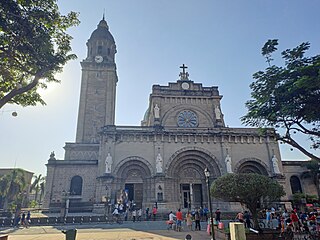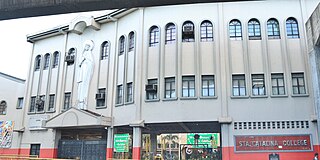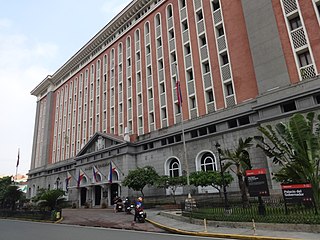
Malacañang Palace, officially known as Malacañan Palace, is the official residence and principal workplace of the president of the Philippines. It is located in the Manila district of San Miguel, along Jose P. Laurel Street though it is commonly associated with Mendiola Street nearby. The term Malacañang is often used as a metonym for the president, their advisers, and the Office of the President of the Philippines. The sprawling Malacañang Palace complex includes numerous mansions and office buildings designed and built largely in the bahay na bato and neoclassical styles. Among the presidents of the present Fifth Republic, only Gloria Macapagal Arroyo actually lived in the main palace as both her office and her residence, with all others residing in nearby properties that form part of the larger palace complex. The palace has been seized several times as a result of protests starting with the People Power Revolution of 1986, the 1989 coup attempt, the 2001 Manila riots, and the EDSA III riots.

Intramuros, is the 0.67-square-kilometer (0.26 sq mi) historic walled area within the city of Manila, the capital of the Philippines. It is administered by the Intramuros Administration with the help of the city government of Manila.

Vigan, officially the City of Vigan, is a 4th class component city and capital of the province of Ilocos Sur, Philippines. According to the 2020 census, it has a population of 53,935 people.

The Church of Saint Augustine, also known as the Archdiocesan Shrine of Our Lady of Consolation and Cincture or the Immaculate Conception Parish, is a Roman Catholic church under the auspices of the Order of Saint Augustine located inside the historic walled city of Intramuros in Manila, Philippines. Completed in 1607, it is the oldest stone church in the country.

The University Belt is the name of a de facto subdistrict in Manila, Philippines, referring to an area that has a significant concentration of major colleges and universities in the city. The districts of Quiapo, Sampaloc, and San Miguel are traditionally considered to be the University Belt, although other clusters of schools that lie along the southern bank of the Pasig River, mostly at the districts of Intramuros and Ermita, as well as the southernmost part of Malate near the city limits are also sometimes included. Each of the colleges and universities found in the district are a short walking distance of each other.
The gates of Intramuros refer to the original eight gates of the Walled City of Intramuros in Manila, built during the Spanish colonial era in the Philippines. The gates are called by the original Spanish word for "gate", puerta.

The Minor Basilica and Metropolitan Cathedral of the Immaculate Conception, which is commonly known as Manila Cathedral, is a Roman Catholic minor basilica and the cathedral church of the Archdiocese of Manila. It is located in Intramuros, the historic walled city in Manila, Philippines, and is dedicated to the Immaculate Conception of the Blessed Virgin Mary, the patron saint of the country.

The Royal and Conciliar San Carlos Seminary is the archdiocesan seminary of the Roman Catholic Archdiocese of Manila. It was established in the year 1702, by decree of King Philip V of Spain. At present, the institution houses seminarians belonging to various dioceses in Luzon, particularly from the Metro Manila region.

The University of Santo Tomas is one of the oldest existing universities and holds the oldest extant university charter in the Philippines and in Asia. It was founded on April 28, 1611, by the third Archbishop of Manila, Miguel de Benavides, together with Frs. Domingo de Nieva and Bernardo de Santa Catalina. It was originally conceived as a school to prepare young men for the priesthood. Located Intramuros, it was first called Colegio de Nuestra Señora del Santísimo Rosario and later renamed Colegio de Santo Tomás in memory of Dominican theologian Saint Thomas Aquinas. In 1624, the Colegio was authorized to confer academic degrees in theology, philosophy and arts. On November 20, 1645, after representations by Vittorio Riccio, Pope Innocent X elevated the college to the rank of a university and in 1680 it was placed under royal patronage.

During the Spanish colonial period in the Philippines (1521–1898), the different cultures of the archipelago experienced a gradual unification from a variety of native Asian and Islamic customs and traditions, including animist religious practices, to what is known today as Filipino culture, a unique hybrid of Southeast Asian and Western culture, namely Spanish, including the Spanish language and the Catholic faith.

Plaza de Roma, also known as Plaza Roma, is one of three major public squares in Intramuros, Manila. It is bounded by Andres Soriano Avenue to the north, Cabildo Street to the east, Santo Tomas Street to the south, and General Antonio Luna Street to the west. The plaza is considered to be the center of Intramuros.

The San Carlos Palace, is a 16th-century Neoclassical mansion in Bogotá, Colombia. Located on the corner of Calle 10 and Carrera 5, the historic building has been the site of various political, social and academic events. Since December 1993, it has been home to the Ministry of Foreign Affairs.

Santa Catalina College is a Roman Catholic, private institution that serves coeducational basic and higher education administered by the Congregation of the Dominican Sisters of St. Catherine of Siena, a religious congregation affiliated with the Dominican Order located in Sampaloc, Manila. It was originally established by the Siena Sisters in 1706.

The Ayuntamiento de Manila is a building located at the corner of Andrés Soriano Avenue and Cabildo Street, fronting Plaza de Roma in Intramuros, Manila, Philippines. Also known as the Casas Consistoriales and also nicknamed as the Marble Palace, the Ayuntamiento was the seat of the Manila City Council, which consisted of two alcaldes, eight oidores (judges), a clerk, and a chief constable. Destroyed in World War II and reconstructed thereafter, the building now houses the offices of the Bureau of the Treasury.

Cuartel de Santa Lucia is a ruined building in Intramuros, Manila, the Philippines.

Colegio de Santa Rosa - Manila is a private Catholic school run by the Congregation of the Augustinian Recollect Sisters in Intramuros, Manila, Philippines. It was established on August 30, 1750 as the Beaterio y Casa de Segunda Enseñanza by Mother Paula de la Santissima Trinidad to educate the young Spanish - Filipino women. It was originally an All Girls school until the early 2000 when it converted to a co-ed educational institution. It acquired its present name on 1774 but was also known by several other names including Colegio de Madre Paula and Beaterio y Casa de Enseñanza.

San Ignacio Church in Intramuros, Manila, Philippines, was designed for the Jesuits by architect Félix Roxas Sr., and completed in 1899. It was known as their "Golden Dream" but was destroyed during World War II. Its interiors, embellished with carvings, had been designed by Isabelo Tampinco.

The Palacio del Gobernador is a government building located in Intramuros, Manila, Philippines. It is located southwest from Plaza de Roma and built in its current form in 1976. At present, the building houses the Intramuros Administration, the Commission on Elections and the Home Development Mutual Fund National Capital Region Office. It also previously housed the Bureau of the Treasury until it relocated across Plaza de Roma to the Ayuntamiento de Manila.
The 1863 Manila earthquake struck the Philippines on June 3, 1863.

















